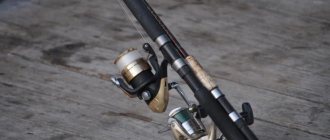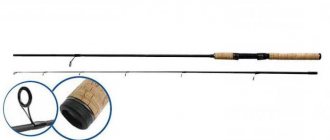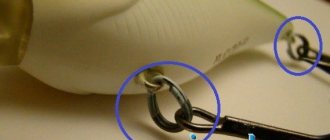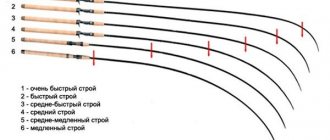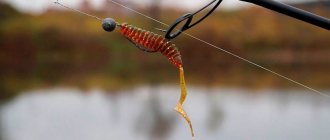Balance of reel and spinning rod, selection rules
20 March 2012 15:56
It is unlikely that anyone will dispute the opinion that fishing is, first and foremost, pleasure. That is why any spinning player wants to get maximum positive emotions both from communicating with nature and from comfortable possession of his tackle. In the latter case, this directly depends on the overall balancing of the tackle, on how well the reel is suitable for a particular fishing rod. The optimal balance of gear means the best match between the reel and the rod in terms of weight, power and sensitivity. Let's look at all these factors in more detail. It is very simple to determine how well a reel with wound fishing line or cord balances a spinning rod. Place the assembled tackle on your index finger and find the center of gravity. If the center of gravity coincides with the grip point, the tackle is well balanced in weight. You can fish with pleasure all day long with this spinning rod, without subsequently feeling any discomfort in your joints and muscles. A well-balanced “reel-rod” system subjectively seems lighter and more sensitive than gear that “pecks” with its nose or falls back. With these options, your arm and back will quickly “ache” and fishing will turn from pleasure into a kind of masochism.
In addition to weight, the reel should also be in harmony with the fishing rod in terms of power. For example, let's use the classification of Shimano reels (Japan)
.
Reels of size 500/1000
are suitable for ultra light class spinning rods with a test weight of up to 7g, sizes
1500/2000
are for light and medium-light rods with a test weight of up to 15-20g, size 2500 is universal and suitable for spinning rods with a test weight of up to 25-30g, reels of standard size over
3000
, as a rule, are installed on powerful long rods for catching large predators. Of course, this classification is not strictly mandatory; often, when mechanically balancing gear, it is better to install a lighter or more powerful reel, depending on the length and weight of the rod.
Casting range and accuracy is another consequence of harmonious spinning tackle. When the place of grip coincides with the center of gravity, the tackle begins to have the best casting properties. The fact is that during casting, your hand with a spinning rod is like a lever, “shooting” the bait forward. The acceleration and impulse of the cast will depend on how well the tackle is balanced. The same applies to casting accuracy. Having practically no parasitic vibrations, a clearly adjusted tackle will allow you to direct your hand with a spinning rod, and behind it the bait, exactly to the target. By the way, such high-precision tackle will also help you when choosing bait. Having practiced casting different types of spinners, you will very soon determine for yourself which specific baits fly most accurately and far from your spinning rod. By saving money on the purchase of baits you don’t need, you will quickly equip your gear with a set of the most “killer” spinners in the literal sense.
The sensitivity or sensitivity of the gear is the last, but no less important, characteristic of a well-balanced reel-rod system.
Being directly in the very center of gravity of the spinning rod, your hand will most accurately determine what is happening with the bait at any given time. Any shocks and stops in the wiring will be immediately transmitted to your hand. Remember that the lighter your reel and spinning rod, the more sensitive the tackle will be overall. That is why all leaders in the production of gear strive to lighten all elements of gear through the use of the most modern and high-tech materials. And who among the fishermen will refuse to reduce their pleasure from biting and fishing for a predator with highly sensitive balanced tackle? Liked? Share with your friends!
Which spinning rod is better for a beginner to choose?
To begin with, let's say a few words about this rod, what is it intended for in the first place.
Spinning is a sports tackle designed for catching, mainly with artificial bait, “predatory fish”, such as: pike, pike perch, bersh, perch, chub, asp, catfish and other representatives of aquatic fauna with fangs and a predatory disposition. Very often, peaceful fish are also caught with a spinning rod, but for this you need to be equipped with one of the types of spinning rods, such as ultralight or light, but for this you need to be in the right place at the right time, and more on that a little later.
Rod build
Action is the bending of a fishing rod under static load, which received the following classification at each stage of bending:
- “Slow, parabolic” - “Slow”;
- “Average” - “Medium, Moderate”;
- “Medium-fast” - “Medium-Fast, Moderate-Fast”;
- “Fast” - “Fast”;
- “Extrafast” - “Extrafast”.
It is most clearly shown in the picture below that spinning rods with an ultra-fast action bend under static load only at the tip, and spinning rods with a fast action bend slightly above the middle. That is, the sooner the spinning rod begins to bend from the butt, the more parabolic it is.
The easiest way to understand what kind of spinning rod is, you can shake it, most often this is called “shaking”.
Holding the edge of the end of the butt part, shake the spinning rod with a slight wave while tracking where it bends; for a more visual example, watch the video below:
After we have learned to determine the structure of the spinning rod, a completely logical question arises: why should we do this and what does it give us?
Now let’s take a look at the purpose of each rod action and its purpose.
“Slow, parabolic” - “Slow”
The structure of a spinning rod, in which the form begins to bend immediately after the butt part (they are also called noodles), to understand what a butt is, let’s look at the image:
Where the second point “b” ends on the right side, there is the edge of the butt (handle). The only exception is probably telescopic spinning rods, in which only the first, thickest leg will not bend.
This type of spinning rod practically eliminates the possibility of fishing with artificial baits such as wobblers and silicone baits, because there will be no required amplitude for hooking, animation of the bait and the necessary sensitivity, but this does not mean that this type of spinning rod is not common and is not popular. Such rods are perfect for fishing with oscillating and rotating spoons, and are also used for catching particularly shy fish, such as asp. This type of rod has the highest casting characteristics - long range, which is perfect for fishing from the shore and will serve as an excellent start when choosing for a beginning spinner.
“Average” - “Medium, Moderate”
The blanks of medium action rods begin to bend approximately from the middle, upper half. These types of fishing rods are also related to parabolic rods, but are closer to semi-parabolic rods due to their versatility. They also have excellent throwing qualities and are suitable for catching wary fish using oscillating and rotating spoons with a more sensitive bite response.
“Medium-Fast” - “Medium-Fast, Moderate-Fast”
A universal system of blanks that can satisfy a wide range of predatory fish lovers, from advanced amateurs to professional athletes. This type of rod is used in all types of spinning fishing (jigging, twitching, spinner fishing), but adjusted to the requirements for the rod based on practical experience. Therefore, this species is mainly caught by experienced fishermen.
"Fast"
Rods of this type are very popular and are perhaps one of the most common. The tip bends from 1/3 of the tip and perfectly signals a bite. These forms are perfect for twitching wobblers, jigging silicone baits and fishing with various jerkbaits and other artificial baits in the form of fish. Typically, spinning rods have good sensitivity and are able to quickly hook fish if handled properly. They cannot boast the same range as parabolics, but among others there are very worthy models.
"Extrafast" - "Extrafast"
This type of rod is also called “evil” or “stingy”. Because They bend at the very edge of the tip and usually the blanks of such rods are very hard and dry. A feature of these forms is the high sensitivity of bites and confident hooking, especially of such fish as pike perch, the upper mouth of which is especially strong and bony.
Rod test
Another important criterion in the guide to choosing a spinning rod is the test. Each spinning rod model is marked with this parameter, which indicates the use of bait weight within this test. As a rule, the test is indicated in the form of 2 numbers, for example: 1 - 7. In this case, it is recommended to use bait weighing no less than 1 and no more than 7 grams, or the test is indicated in ounces, for example “1 oz”, which means rounded up to 28 grams .
These designations indicate that in the manufacture of the blank exactly the amount of material was used that can withstand when working with the maximum weights of baits, casting, etc. But this is not an indication that you will not be able to cope with large fish; in this case, very delicate fishing is required without jerking or forcing.
More often, the indicated figures are not a standard for working with the maximum permissible weight, because... Many fishing rods have a certain safety margin, but in this case it is recommended to follow the manufacturer's instructions.
Spinning rods, depending on the test, have the following classification:

“Ultralight - Ultra Light, UL” is a class of the lightest spinning rods designed for catching small predators, most often perch or chub. Very light baits are used, which will ensure proper casting thanks to such a spinning rod and correctly selected fishing line.
“Light, light - Light, L” - also used for catching small predators using small baits, can be used on rivers with weak currents.
“Medium Light, Medium - Medium Light, M” is a universal test range that is comfortable for fishing on almost any type of reservoir. For this class, the largest abundance of various baits is provided.
“Medium Heavy, Heavy, MH, H” - more often used for fishing in large bodies of water with fairly strong currents and large predatory fish. In Russia, this class is more applicable to the Volga River and other similar large rivers and reservoirs.
“Extra Heavy, EH” - is also often used for fishing on the Volga and rivers with strong currents, large reservoirs. But they are also designed for sea fishing.
Rod length
The length of the spinning rod affects the ease of use in certain fishing conditions. Basically, it is worth highlighting several criteria:
- Fishing from a boat;
- Fishing from the shore.
The most comfortable spinning rod for fishing from a boat will be up to 2 meters 10 centimeters long. These figures were obtained based on many years of experience in fishing with professional spinning rods and are often taken as a standard. More often this recommendation is used for fishing with twitching spinning rods, because... the length is optimal for ease of use of the rod in the boat and comfortable retrieving and animation of the bait.
For shore fishing, it is recommended to use spinning rods over 2 meters 40 centimeters in length, which will provide you with greater range, which is a key factor in shore fishing on large bodies of water, medium and large rivers. The exception in this case is small reservoirs and small rivers, where this is not so important.
Conclusion
In conclusion of the article, I would like to add that this is by no means everything that I would like to say, but it is better to limit ourselves to the necessary minimum for the initial stage, because you can say a lot about the materials of manufacture, accessories, types of spinning rods - for jigging, twitching. But we will write about this consistently.
Sincerely yours, Rybolovny.ru.
